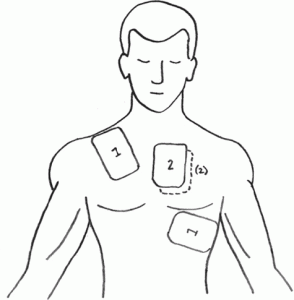In honor of 5/20/16, a day in which the Sinai ED managed three cardiac arrest patients in less than one hour, I wanted to post a pearl relevant to one of the cases we saw.
Our initial goal during a Vfib arrest resuscitation is to optimize uninterrupted compressions and deliver a shock as soon as possible. As such, pads are typically placed in the right anterior chest and left lateral positions. The airway will be secured and anti arrhythmic agents will be given (amiodarone, lidocaine, etc.) along with other ACLS meds. However, when patients remain in Vfib after multiple defibrillations there are additional options that our guidelines do not tell us.
There is significant anecdotal evidence that changing pad placement can increase the success rate of defibrillation. Many providers would advocate for placing a second set of pads anteriorly and posteriorly. If the patient fails to convert after being shocked with this new pad placement, multiple case studies have showed success at achieving ROSC by using double sequential defibrillation. When performed, two defibrillators are charged to maximal energy and shocks are administered simultaneously.
Limited data exists on double sequential defibrillation. It should be considered, however, in cases of refractory Vfib.
References:
1) Myers, Brent & Braude, Darren. A Fib Gets the Royal Treamtent: Out of Hospital Cardiac Arrest. EM:RAP. February 2016
2) Myers JB et. al. Double Sequential External Defibrillation in Out-of-Hospital Refractory Ventricular Fibrillation: A Report of Ten Cases.Prehosp Emerg Care. 2015 January-March;19(1):126-130
3) Lybeck AM et. al. Double Sequential Defibrillation for Refractory Ventricular Fibrillation: A Case Report. Prehosp Emerg Care. 2015;19(4):554-7

